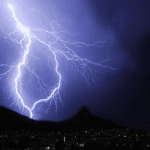
Lightning is just one source that can cause power surges. They can also originate from the electric utility company during power grid switching and inside a home when large appliances like air conditioners and refrigerator motors turn on and off.
Power surges can enter a home through several paths. Lightning can take the path of the cable TV or satellite dish cable, through the incoming telephone lines or through incoming electrical service lines.
A good surge protection system should include:
- Protection of the incoming electrical service
- Some type of protection of phone lines and cable TV lines
- Point-of-use surge protectors at senstive and expensive appliances
You can also install a whole house surge arrestor. These units are installed near your electric meter where the power lines run into your home or building. This protects all the circuits in your home or building from a certain range of voltage surges. Units designed for whole house protection are generally built for outdoor installation.
Although a whole house surge protector will suppress power surges stemming from outside sources, it won’t do anything to suppress the high number of power surges that originate from inside your house due to the operations of your appliances.
When deciding on what type and how much surge protection is needed, each house and its contents should be assessed individually. An electrician knowledgeable about power surge protection systems and the history of problems in your area is a valuable resource.
For more information on protecting your home and business, please call E. R. Munro and Company at 877-376-8676 or visit our Web site at www.ermunro.com.

